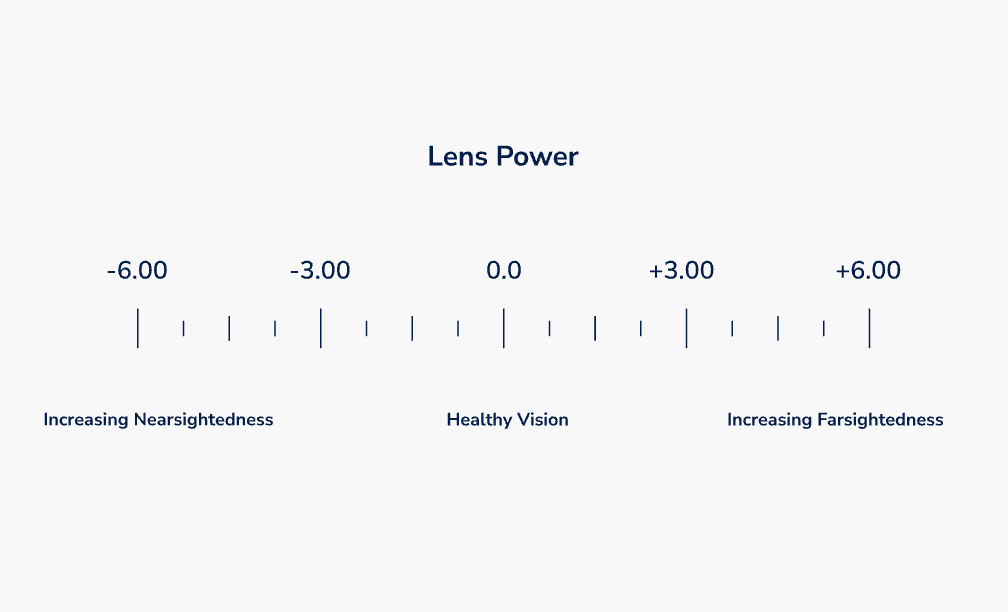Easy to understand in just a few minutes
When your Optician first hands you your contact lens prescription, it probably won’t make sense to you. But fear not. By the time you’re done reading this blog, you’ll be able to look at a contact lens prescription and explain what all those abbreviations and numbers mean. Why is that important? Well, for one, it helps you understand your eyes, and how they work. But secondly, when your box of contact lenses shows up, it helps you double check that the lenses you received are the ones you ordered. Let’s get started!
What do all the numbers and abbreviations mean?
On the contact lens prescription above, you’ll notice some shorthand that Opticians use to quickly communicate which lenses will correct your vision. In the next few sections, we’ll go over them one by one.
Starting with the left column
O.D. is short for oculus dexter, which is Latin for “right eye.” O.S. is short for oculus sinister, which is Latin for “left eye” (though we see nothing sinister about a left eye vs. a right eye).
Now looking at the rows from left to right:
POWER, sometimes labelled as sphere, SPH, or D is the power needed to correct your vision. A minus sign means you’re nearsighted and a plus sign indicates you’re farsighted. The number next to the minus or plus is measured in diopters, a funny word for the way they measure how much correction is needed. It’s also where the abbreviation “D” comes from. If you’re at a zero, it means your vision is just about perfect, you need no correction. The further away from zero you get, the stronger the lens you’ll need to correct your vision.

ADD, or additional lens power needed for reading, is included for people who have presbyopia. You may have noticed that many older people need to hold their phone or restaurant menu at arm’s length to read. This natural loss of the ability to focus or see things clearly up close is a normal part of aging and is corrected by the ADD.
BC, or base curve, is the curvature of your contact lenses. Measured in millimeters, it’s one of the factors that determines how well a lens fits your eye.
DIA, or diameter, is the width of your lenses, also measured in millimeters.
Prescriptions for astigmatism
Since astigmatism occurs when your eye is not uniformly spherical, correcting astigmatism means a few more measurements.
CYL, or cylinder, works similarly to the POWER, or sphere measurement, but indicates that you’ll need a different kind of lens to correct your vision—one that corrects for the unique shape of your eye or eyes. Specifically, cylinder compensates for the degree of astigmatism you have. The higher the number, the more irregular the shape of your cornea.
AXIS is a measurement of the orientation of your personal astigmatism (it’s unique to you). It’s always between 0 and 180 degrees. If you think of astigmatism as your cornea shaped more like a lemon than a football, AXIS measures the tilt of the lemon shape.
Names and dates are important, too
A contact lens prescription will have some information that isn’t just about your contact lens fit. For starters, your name. And with that fact, it’s a good time to drive home the point that a contact lens prescription is tailored to your eyes and your eyes only. Your contact lenses should never be shared with anyone else.
The two dates include the date your prescription was issued, and the expiration date of the prescription, which is typically a year later (and different than the expiration date of the contact lenses you’ll purchase).
Can you convert your glasses prescription to a contact lens prescription?
You may be able to find conversion calculators online, but contact lenses are considered medical devices, so you’ll need an Optician to write you a prescription specific to contact lenses. Since glasses sit away from your eyes and not on them like contact lenses, the prescription can actually be a little bit different. Additionally, glasses prescriptions will not provide the base curve (BC) that's needed for the lens to fit on your eye correctly.
How to get a contact lens prescription
You’ll need to schedule a contact lens fitting appointment. After your appointment, you’ll probably go home with some free trial lenses to try. You’ll typically go back to see your Eye Care Professional after a few days to have the vision, comfort and fit on your eye verified. Then you’ll be given your contact lens prescription.
Put it all into practice
Congratulations, you now have the knowledge to understand your contact lens prescription. Test your newfound knowledge with this example contact lens package. Then, when your next package of contact lenses arrives, you’ll be able to confidently double check the box to make sure your prescription matches the contact lenses you have received.